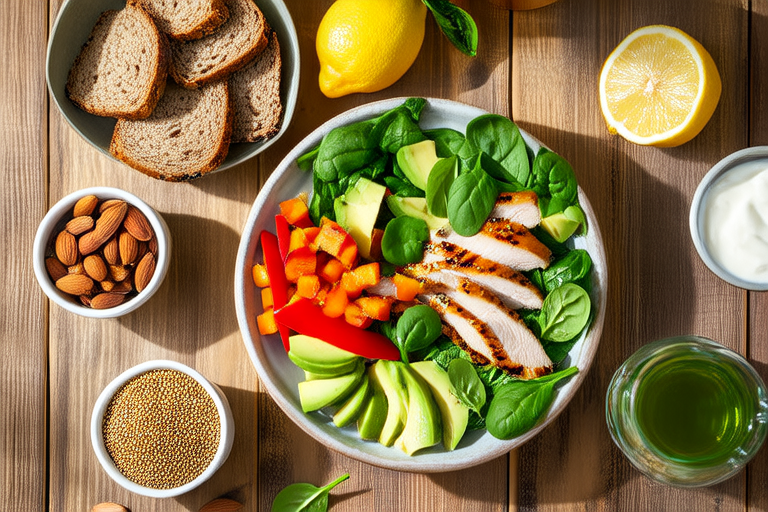10 Essential Guidelines for a Balanced and Healthy Diet
A balanced and healthy diet is the cornerstone of overall well-being. It not only provides the energy needed to tackle daily activities but also supports physical, mental, and emotional health. A proper diet helps maintain a healthy weight, reduces the risk of chronic diseases like diabetes and heart disease, and promotes longevity. However, with so much conflicting information available, it can be challenging to know where to start. This article outlines ten essential guidelines to help you achieve a balanced and nutritious diet that works for your lifestyle.
1. Prioritize Whole Foods Over Processed Options
Whole foods are minimally processed and retain most of their natural nutrients. Examples include fresh fruits, vegetables, whole grains, nuts, seeds, and lean proteins. These foods provide essential vitamins, minerals, fiber, and antioxidants that support bodily functions. On the other hand, processed foods often contain high levels of added sugars, unhealthy fats, and sodium, which can harm your health over time. To incorporate more whole foods into your diet, try swapping white bread for whole-grain bread, choosing fresh fruit instead of sugary snacks, or opting for homemade meals over pre-packaged ones.
2. Include a Variety of Food Groups
No single food contains all the nutrients your body needs. That’s why it’s important to eat a variety of foods from different food groups. Aim to include fruits, vegetables, grains, proteins, and dairy (or fortified alternatives) in your daily meals. For example, a balanced plate might consist of grilled chicken (protein), quinoa (grain), steamed broccoli (vegetable), and a side of mixed berries (fruit). Eating a diverse range of foods ensures you get a broad spectrum of nutrients, such as calcium from dairy, iron from meats, and fiber from grains and vegetables.
3. Control Portion Sizes
Even healthy foods can contribute to weight gain if consumed in excess. Controlling portion sizes is key to maintaining a balanced diet. Use smaller plates, measure servings, and avoid eating directly from large containers. For instance, a serving of cooked pasta should be about the size of a tennis ball, while a portion of meat should resemble a deck of cards. Being mindful of portions helps prevent overeating and keeps calorie intake in check without depriving yourself of the foods you enjoy.
4. Limit Added Sugars and Salt
Excessive consumption of added sugars and salt can lead to serious health issues, including obesity, high blood pressure, and heart disease. To reduce your intake, read food labels carefully and choose products with lower sugar and sodium content. Swap sugary beverages like soda for water or herbal tea, and season your meals with herbs and spices instead of salt. For example, sprinkle cinnamon on oatmeal instead of adding sugar, or use lemon juice and garlic to flavor roasted vegetables.
5. Stay Hydrated
Water is vital for digestion, nutrient absorption, temperature regulation, and many other bodily functions. Staying hydrated also helps curb unnecessary snacking, as thirst is often mistaken for hunger. Aim to drink at least eight glasses of water per day, adjusting based on activity level and climate. Carry a reusable water bottle with you to make hydration convenient. If plain water feels boring, infuse it with slices of cucumber, lemon, or mint for a refreshing twist.
6. Incorporate Healthy Fats
Fats are an essential macronutrient, but not all fats are created equal. Focus on consuming healthy fats found in foods like avocados, nuts, seeds, olive oil, and fatty fish such as salmon. These fats support brain function, hormone production, and cell growth. Avoid trans fats and limit saturated fats found in fried foods, baked goods, and processed snacks. For example, spread mashed avocado on whole-grain toast instead of butter, or drizzle olive oil over a salad for added flavor and nutrition.
7. Eat More Fiber-Rich Foods
Fiber plays a crucial role in digestive health and helps regulate blood sugar levels. It also promotes feelings of fullness, making it easier to manage weight. Foods rich in fiber include fruits, vegetables, legumes, whole grains, and nuts. Start your day with a bowl of oatmeal topped with berries, or add beans to soups and stews for an extra fiber boost. Gradually increase your fiber intake to avoid digestive discomfort, and ensure you drink plenty of water to aid digestion.
8. Plan and Prepare Meals Ahead of Time
Meal planning and preparation can save time, reduce stress, and prevent impulsive unhealthy choices. Set aside a few hours each week to plan your meals, create a shopping list, and prep ingredients. For example, chop vegetables, cook grains, or marinate proteins in advance so they’re ready to use during busy weekdays. Having healthy options readily available makes it easier to stick to your dietary goals and resist the temptation of fast food or takeout.
9. Practice Mindful Eating
Mindful eating involves paying attention to what and how you eat, helping you develop a healthier relationship with food. Slow down during meals, savor each bite, and listen to your body’s hunger and fullness cues. Avoid distractions like TV or smartphones while eating, as they can lead to overconsumption. For instance, put your fork down between bites and chew thoroughly to fully appreciate the flavors and textures of your food. This practice fosters better digestion and prevents overeating.
10. Allow Room for Treats in Moderation
A balanced diet doesn’t mean eliminating your favorite treats entirely. Depriving yourself can lead to cravings and binge-eating later on. Instead, allow yourself occasional indulgences in moderation. For example, enjoy a small piece of dark chocolate after dinner or share a dessert with friends during special occasions. By practicing balance and flexibility, you can maintain a sustainable and enjoyable eating pattern without feeling restricted.
Conclusion
Adopting a balanced and healthy diet is one of the most impactful steps you can take toward improving your overall well-being. By prioritizing whole foods, controlling portions, staying hydrated, and incorporating these ten guidelines into your lifestyle, you can nourish your body effectively while still enjoying the foods you love. Remember, consistency is key—small, gradual changes are more sustainable than drastic overhauls. Over time, following these principles will not only enhance your physical health but also boost your mental clarity, energy levels, and quality of life. Start today, and reap the lifelong benefits of a balanced diet.










